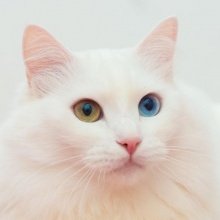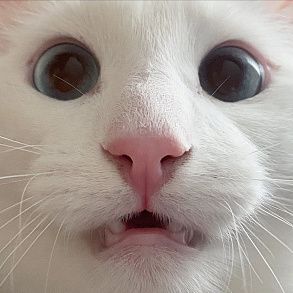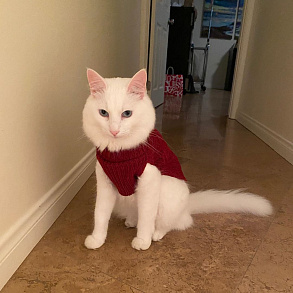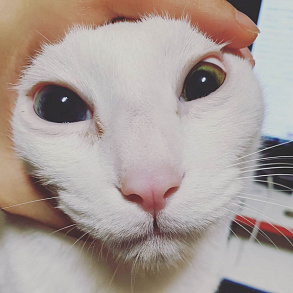Turkish Angora

Turkish angora is one of the oldest native breeds in the world. This is a graceful and sociable cat with a long silky coat.
Brief information
- Breed name: Turkish angora
- Country of Origin: Turkey
- Birth time of the breed: 1973
- Weight: 2.5 – 5 kg
Highlights
- Turkish angoras are attached to only one owner, so they are perfect for lonely people.
- Angora cats get along without problems in a large family and together with other animals, but due to their instincts they start hunting for smaller pets.
- The main signs of the breed: smooth silky fur without undercoat, elegant flexible body and a very long fluffy tail.
- Despite the exotic appearance, cats do not need complex care or the preparation of a special diet.
- Turkish angoras love to hunt and play, so if they don't have enough space, they can make a mess in the apartment.
- These cats never meow loudly, do not "row", demanding food or the attention of the owner.
- If you have accustomed a kitten to water from a young age, you can be sure that an adult pet will learn to swim perfectly.
- Angora cats are smart, easy to learn and amenable to training.
- Regular visits to the veterinarian, a balanced diet and the attention of the owner will ensure a long life for the animal – up to 15-20 years.
Turkish angora is a favorite breed of aristocrats and rulers, having a centuries-old history of development. Angora cats of snow-white color with blue or bicolor (one blue, the other yellow) eyes are especially appreciated. The mobile playful animal requires minimal care and is well trained. A majestic and graceful pet is attached to only one person, whom it recognizes as the owner.
Breed characteristics
History of the Turkish Angora breed
Felinologists have not been able to find out exactly when and how this breed originated – Angora cats have lived next to humans for many centuries. Presumably their ancestor was a Caucasian forest cat who lived in Turkey in the Middle Ages. The breed appeared and developed on the territory of this state, being named after the city of Ankara, which has been the capital since 1923. For the first time, wayward fluffy pets were mentioned in local legends of the XV century. Only noble persons could afford to keep white cats with bicolor eyes, although other colors were also natural. It was believed that the ruler of Turkey should be a man who would be bitten by such an animal. Another legend explaining the veneration of Angora cats says that one of the national saints had eyes of different colors.
Interesting fact: modern Turkish angoras do not look like their "great-grandparents": for a long time they have undergone changes, but they still have an unusual coat, grace and refinement.
In Europe, the Turkish angora appeared at the beginning of the XVII century thanks to an Italian aristocrat. Traveling through Turkey, Persia and India, he became interested in unusual white cats with long fur. The Italian took a couple of fluffy beauties with him.
Turkish angora immediately became very popular, especially at the French court. It is known that one of the first owners of the Angora cat in Europe was none other than the almighty Cardinal de Richelieu. Later, the pets of this breed were chosen by no less famous Frenchmen: Louis XIV, Marie Antoinette, Victor Hugo, Theophile Gautier. The Angora cat was a favorite of the Russian Empress Catherine the Great. However, despite its popularity, no one was engaged in its systematic selection.
At the beginning of the XIX century, the breed came to the USA, but quickly became auxiliary, serving for breeding persian cats . At home in 1917-1930, the Turkish angora was recognized as a national treasure. The government has established a program to restore the breed that has begun to fade in the Ankara Zoo nursery. The lack of systematic breeding forced European and American breeders to recreate the population in the 1950s.
Officially, the Turkish angora was recognized only in 1973 by the CFA Association (USA). Initially, only white cats were considered to meet the standard, but by 1978 it was possible to prove the traditionality of other suits. Today the breed has a champion status in all world felinological organizations. To preserve the gene pool, since 1996, the Turkish government has closed the export of white angoras from the country, but left the possibility of exporting cats of other colors that are considered equivalent. Interestingly, in Turkey, snow-white Angora cats with multicolored eyes are allowed into mosques.
Video: Turkish Angora
Appearance of the Turkish angora
Turkish angora is an elegant medium–sized cat. The flexible elongated body is quite muscular and graceful. Females weigh 2.5-3.5 kg, males can be 2 times larger. When evaluating, experts pay more attention to the balance of the physique than the size of the animal.
Head
A flat skull and high cheekbones form a wedge-shaped head with a smooth silhouette. The forehead gently turns into a straight nose. The rounded chin in profile is perpendicular to the nose.
Eyes
Large, set wide, have a rounded, slightly oblique shape. Usually blue, green or yellow, individuals with differently colored eyes are often found.
Ears
Large, high-set ears have a wide base and are arranged vertically. Inside there is a thick "brush" of fur, there are small brushes on the tips.
Neck
The pronounced graceful neck of the Turkish angora has an average length.
Body
Medium-sized, fit and slim. The croup is slightly above the shoulders.
Legs
Slim and tall. The hind limbs are slightly longer than the forelegs. It is desirable that there are characteristic tufts of wool between the fingers.
Tail
Fluffy, almost as long as the body, tapering to a wedge-shaped tip.
Wool
The semi-long cover of the Turkish angora is very soft, crumbly, there is practically no undercoat. In the area of the "pants" and collar, the wool is slightly longer than on the rest of the body.
Color
Until today, snow-white Angora cats are in favor, but cream, brown, tabby, smoky, red colors are also considered acceptable.
The character of the Turkish Angora
The Angora cat has an independent, wayward character. Usually the pet behaves calmly, but sometimes likes to run, knocking everything in its path, so it is advisable to provide enough space for games. The cat loves mouse toys, although it will not refuse to live. If you take an object of fun from her during the game, she will not rest until she takes it away or demands it back. Turkish Angora is very persistent and purposeful. He loves walking passionately and climbs somewhere higher with pleasure. This cat does not like to sit on its knees for a long time, but strives to capture the attention of others, while never meowing loudly, not scandalizing, but "talking" with the help of uterine purring sounds. Turkish angora gets along well with pets, family members, but considers only one person the owner.
Cats of this breed have a developed hunting instinct, so they are happy to master various toys, arrange ambushes. If the owner teaches the kitten to water procedures, then the adult pet will insist on bathing himself. Turkish Angora have a developed intelligence, if desired, easily opening bags, cabinets, doors. Animals can also learn how to bring objects, turn on and off lights. Your pet will reliably hide her own toys from outside encroachments. The cat suffers without human attention, but is always ready to support the sick owner.
Angora treats strangers with caution, takes a long time to get used to new faces. The pet is obedient, easily accustomed to the scratching post, tray and rules of behavior in the house. If an animal is offended by the owner for some reason, it will specifically violate the established order as revenge.
Care and maintenance
Turkish angoras need minimal care. In a healthy animal, the silky coat does not get tangled, so it is enough to comb it 2 times a week. White cats are bathed once every 2-3 months, using special conditioners that prevent yellowing of the coat. Pets of other colors can be washed even less often. It is necessary to regularly inspect the ears and eyes of the angora, if necessary, wipe the shells with special lotions. Once a week, you need to brush your teeth with special pastes, wipe your ears and eyes. This will avoid the appearance of inflammation, the formation of tartar.
Take care of the animal's leisure so that your pet does not spoil the furniture: buy a multi-level "cat tree", a scratching post, a set of toys. Get a house for the cat – personal space will become a reliable shelter for angora, will allow her to hide her favorite toys and just relax. If you have accustomed your pet to a scratching post, there is no need to trim the claws.
This breed has no special preferences in terms of nutrition. The most important criteria are the balance of the diet and its sufficient fortification. Kittens should be fed 4-5 times a day, accustomed to fermented milk products. Otherwise, you will have to buy calcium supplements that ensure the normal mineralization of tooth enamel and the growth of claws. Adult animals need to be fed 2 times a day at a strictly defined time. During the molting period, increase the intake of fat–soluble vitamins - this will help reduce hair loss. A natural diet should include:
- fermented milk products (but not milk);
- boiled or frozen meat, offal, fish;
- raw or boiled eggs;
- vegetables.
White Angora cats are not recommended to be fed with hearts, liver, sea cabbage – all this contributes to the yellowing of the fur. This restriction does not apply to other colors. Completely protect your pet from consuming fried, peppery, too salty foods, sweets. When choosing ready-made feeds, give preference to the highest quality products for long-haired cats.
Health and diseases of the Turkish Angora
Turkish angora has good health, allowing the pet to live up to 15-20 years with proper care. Adults may suffer from congenital diseases and tartar. Kittens are susceptible to ataxia and other ailments, so up to six months it is important to constantly monitor the veterinarian. Old cats sometimes suffer from cardiomyopathy, suffer from tumor neoplasms.
White individuals with blue eyes are often born deaf, although their character does not change from this. It is better to completely transfer such animals to home maintenance and walk them on a harness. In bicolor cats, deafness can affect only one ear (from the side of the blue eye).
How to choose a kitten
If you want to buy a healthy kitten that really belongs to the Angora breed, contact only specialized kennels. Be sure to look at the pedigree of the parents. For snow-white kittens, the queue of buyers is lined up a few months before the next litter is born. If you want to get a furry friend earlier, pay attention to Turkish angoras of other colors. The kitten must stand confidently on its feet, be accustomed to food. Healthy animals are playful, although cautious, do not have creases on the tail, areas of matted fur.
How much does Turkish angora cost
The price depends on the purity of the pedigree, color and health of the cat. In Russia, a non-exhibition Angora kitten can be bought for $70 - $80. The most expensive are breeding individuals, which will later be used by breeders for breeding the breed, as well as pets that meet the strictest standards, suitable for participation in exhibitions. The cost of elite kittens of Turkish angora comes to $250 - $300.


